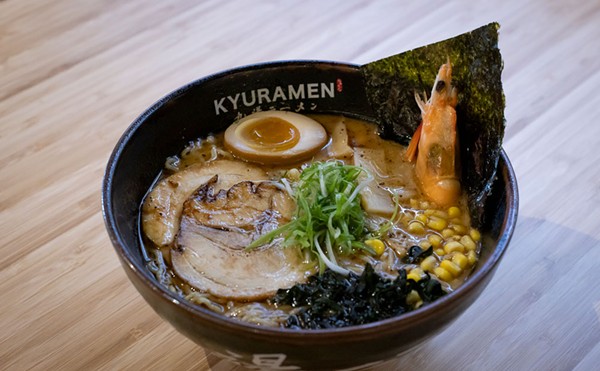Here in the United States we celebrate the rollover of the yearly odometer at midnight Dec. 31, but the rest of the world has differing ideas about when the new year begins. Rosh Hashanah, the Jewish New Year, is celebrated every autumn, while Chinese New Year, celebrated throughout East Asia, marks the beginning of spring. Meanwhile, Muslim New Year (Ras as-Sana al Hijreya) slides around the calendar like a pig on ice, a fact you may never have noticed since the entire celebration consists of quietly contemplating mortality.
No matter whether you’re celebrating the new year’s arrival by watching the ball drop while singing “Auld Lang Syne” in Times Square or pitching firecrackers at Chinese dragon parade dancers in Beijing, chances are you’ll be celebrating afterward with strikingly similar chow. Nearly every culture seems to eat for luck – universally employing certain foods on New Year’s Day in hopes of attracting wealth, love or other good fortune during the rest of the year. Do a bit of research and you find that these ritual edibles fall more or less into three categories: foods that remind people of money, foods that swell, and round foods (includes the subcategory of inedible round objects inserted into food).
Greens, i.e. leafy vegetables, are the main money food because green is commonly the color of currency, and also, greens fold like paper money. In Germany and Eastern Europe the green of choice is cabbage; in the U.S. it’s usually kale or collards, while some Chinese New Year’s eats are wrapped in lettuce leaves because in Cantonese dialect the word for lettuce sounds much like the word for “rising fortune.” Fat-licious pork products are also popular New Year’s good fortune fare, since it is hoped that prosperity will follow after eating such a “rich” food.
Foods that swell symbolize progress and prosperity, expanding several times over as they cook in the same way you want your fortune to grow. Rice appears in many cultures, from the Deep South to, big surprise, every country in Asia; besides growing in volume as it cooks, its many grains signify abundance. Noodles are another food that swell as they cook; the Japanese literally suck down super-long soba noodles, representing long life, one at a time on New Year’s Eve. (It’s considered really bad juju to break the strand, though.) Same deal in China, where uncut noodles are also eaten to symbolize longevity and uninterrupted good health in the coming months.
Round foods are doubly propitious, symbolizing the continuity of the rebirth of old into new as well as wealth – y’know, because coins are round. Thus lentils are lucky in Italy, Brazil and Germany, while all kinds of countries believe it’s particular good luck to eat circular cakes with lucky tokens – yes, round, like coins and rings – baked inside. In Greece the first slice of the vassilopitta is reserved for St. Basil, but he who finds the coin baked inside is in for an especially lucky year. Same in Mexico for whoever finds the clay doll baked into the rosca de reyes (king’s cake). In Latino countries there is a midnight ritual of eating 12 (round) grapes right at midnight on Dec. 31 – one for each chime of the clock. This one appears to be a less-than-organic tradition, originating just a century ago when grape growers in Spain, facing a particularly abundant grape harvest, invented it to divest their surplus.
Turns out that a New Year’s tradition that many of us find familiar, Hoppin’ John, is a sort of good-luck superfood combining all three propitious categories and then some. It’s got the rice, abundant and swelling, with the (reasonably round, more or less coin-like) black-eyed peas, and it is often cooked with a hog jowl – fat meat equals fat bankroll – and served with money-green collards. Some cooks super-size the luck by tossing a shiny dime into the cooking pot; the person who gets it in his or her bowl has extra good fortune coming, possibly starting with the successful Heimlich maneuver performed by their tablemates. This one-pot dish of rice and legumes is an important indigenous staple in West Africa, and was imported to the U.S. along with the slave trade. The more you eat, the luckier you’re supposed to be – only, be sure to leave three peas on your plate: one each for romance, wealth and health. These leftovers supposedly ensure an abundance of each coming your way.
recipe:
Hoppin’ John
The old Southern saying goes, “Eat poor on New Year’s Day and you’ll eat rich the rest of the year. Rice for riches and peas for peace.” Hoppin’ John is supposed to be the first thing you eat in the New Year; since I’m often feeling, let’s just say, not so spiffy on the morning of Jan. 1, I recommend making the Hoppin’ John a day ahead of time. (Anyway, the longer it sits, the better it tastes.) Or try my shortcut recipe involving frozen black-eyed peas, which shaves a couple of hours off the cooking time without sacrificing flavor.
• 16-ounce package frozen black-eyed peas
• 1 medium onion, chopped
• 1 green bell pepper, diced
• 2 cloves garlic, chopped fine
• Smoked ham hock, meaty ham bone or 6
slices bacon
• 2 teaspoons Cajun seasoning (like Tony
Cachere’s)
• Stock (or water) – around 2 cups
• 1 can diced tomatoes with green chilies
(reserve juice)
• 1 cup long-grain white rice
If using the bacon: In a deep pot, cook bacon over medium heat until crisp. Remove bacon; reserve. Saute the onion, garlic, bell pepper and Cajun seasoning in the bacon drippings (or just use 2 tablespoons oil) until beginning to soften, three or four minutes. Stir in black-eyed peas and tomatoes, then add the ham hock or bacon and enough stock (or water) to barely cover everything. Bring to boil, then lower heat and simmer uncovered for 30 minutes. If using ham hock or bone, take it out now, remove meat and dice, and return to pot.
Turn flame back to medium-high and add rice along with reserved tomato juice plus enough water to make 2 cups. Bring to a boil, then reduce to low, cover and cook 15 minutes until rice is done. Taste and add salt if needed – between the Cajun seasoning and ham, it likely won’t. Crumble bacon on top, if you went the bacon route; sliced scallions are nice, too. Serve with plenty of hot sauce, cooked collards and corn bread for a happy New Year (or at least a happy belly).


















